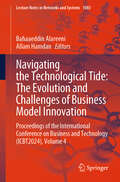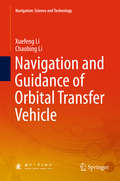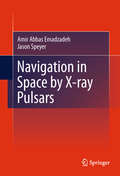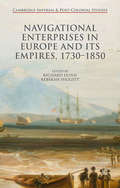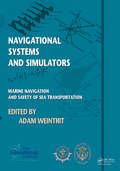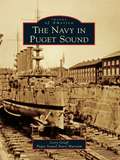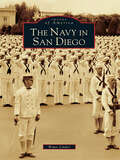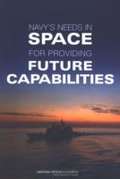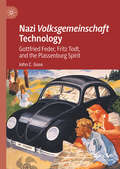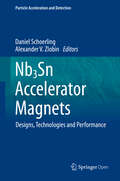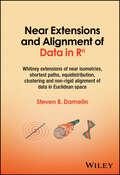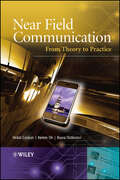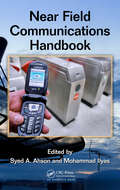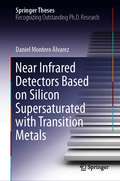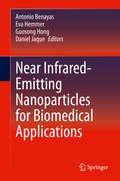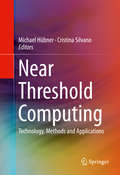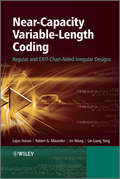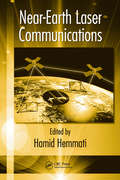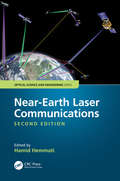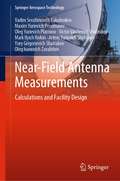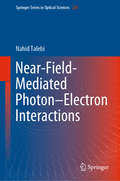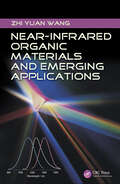- Table View
- List View
Navigating the Technological Tide: Proceedings of the International Conference on Business and Technology (ICBT2024), Volume 3 (Lecture Notes in Networks and Systems #1082)
by Allam Hamdan Bahaaeddin AlareeniIn an era defined by technological breakthroughs such as AI, blockchain, and IoT, this book offers a fresh and practical approach to Business Model Innovation (BMI). It delves into how technological advancements drive new business models and enhance operational efficiency, providing actionable insights and real-world examples for business leaders, strategists, operations managers, entrepreneurs, and students in business and technology disciplines. Encouraging diverse research methods, including theoretical, empirical, and multimethod studies, it welcomes manuscripts with clear managerial or policy implications. Aimed at students, scholars, researchers, professionals, executives, government agencies, and policymakers, this book equips readers with tools to succeed in today's dynamic business environment and supports multidisciplinary research to advance innovation management practices.
Navigating the Technological Tide: Proceedings of the International Conference on Business and Technology (ICBT2024), Volume 4 (Lecture Notes in Networks and Systems #1083)
by Allam Hamdan Bahaaeddin AlareeniIn an era defined by technological breakthroughs such as AI, blockchain, and IoT, this book offers a fresh and practical approach to Business Model Innovation (BMI). It delves into how technological advancements drive new business models and enhance operational efficiency, providing actionable insights and real-world examples for business leaders, strategists, operations managers, entrepreneurs, and students in business and technology disciplines. Encouraging diverse research methods, including theoretical, empirical, and multimethod studies, it welcomes manuscripts with clear managerial or policy implications. Aimed at students, scholars, researchers, professionals, executives, government agencies, and policymakers, this book equips readers with tools to succeed in today's dynamic business environment and supports multidisciplinary research to advance innovation management practices.
Navigation and Guidance of Orbital Transfer Vehicle (Navigation: Science And Technology Ser.)
by Xuefeng Li Chaobing LiThis book uses the entire flying process, starting from ground launching of the orbital transfer vehicle (OTV) to injecting payload into earth synchronous orbit, as an example for real-world engineering practices. It discusses in detail the analysis design and integrated OTV navigation and guidance system technologies in combination with the engineering experiences of the authors in analysis, design and integrated OTV navigation and guidance system applications, and the research on navigation and guidance theories. It focuses on establishing motion of air vehicle equations, control system hardware components, orbit prediction technology, inertial navigation and initial alignment technologies, INS/GNSS integrated navigation technologies, INS/CNS integrated navigation technologies, redundant fault tolerance and failure reconfiguration technology of inertial sensors, guidance and midcourse correction technologies and orbit control strategies. The book is a valuable reference book for the engineers, technicians and researchers who are engaged in analysis, design and integrated application of OTV navigation and guidance control systems. It can also be used as teaching material for postgraduates and senior undergraduates majoring in OTV navigation and guidance systems and other related subjects.
Navigation in Space by X-ray Pulsars
by Jason Lee Speyer Amir Abbas EmadzadehNavigation in Space by X-ray Pulsars will consist of two parts. One is on modeling of X-ray pulsar signals. The second part explains how X-ray pulsar signals can be used to solve the relative navigation problem. This book formulates the problem, proposes a recursive solution, and analyzes different aspects of the navigation system. This book will be a comprehensive source for researchers. It provides new research results on signal processing techniques needed for X-ray pulsar based navigation in deep space.
Navigational Enterprises in Europe and its Empires, 1730–1850 (Cambridge Imperial and Post-Colonial Studies Series)
by Richard Dunn Rebekah HiggittThis book explores the development of navigation in the eighteenth and nineteenth centuries. It examines the role of men of science, seamen and practitioners across Europe, and the realities of navigational practice, showing that old and new methods were complementary not exclusive, their use dependent on many competing factors.
Navigational Systems and Simulators: Marine Navigation and Safety of Sea Transportation
by Adam WeintritThe TransNav 2011 Symposium held at the Gdynia Maritime University, Poland in June 2011 has brought together a wide range of participants from all over the world. The program has offered a variety of contributions, allowing to look at many aspects of the navigational safety from various different points of view. Topics presented and discussed at th
Navy in Newport, The (Images of America)
by Lionel D. WyldKnown throughout the world as "The City by the Sea," Newport, Rhode Island, has a long history of maritime activity. Since the Colonial period, Newport has been recognized as both an important seaport for the mercantile trade and a harbor of inestimable value for naval vessels. I n 1869, the U.S. Navy opened its pioneer site in the region, the Naval Torpedo station on Goat Island in Newport harbor. The Naval War College on Coasters Harbor Island and the Naval Training Station soon followed. The navy's presence expanded through two world wars; and in the 1940s the U.S. Naval Operating Base with headquarters in Newport, included extensive naval facilities on both sides of Narragansett Bay. Today, Newport remains an integral site of naval training, research, and development. The prestigious Naval War College, the Naval Education and Training Center, and other navy command schools, in addition to the Naval Undersea Warfare Center with its Division Newport, have kept this branch of the armed services a leading employer in Rhode Island and southeastern New England.
Navy in Puget Sound, The (Images of America)
by Cory Graff Puget Sound Navy MuseumEven before settlers came to the Puget Sound, the U.S. Navy was exploring the sheltered inlets and deep water ports of what was dubbed "America's Mediterranean." In 1856, the sailors of the navy warship Decatur repelled an attack by Native Americans, saving a tiny village on the shores of Elliott Bay named Seattle. In the ensuing years, Puget Sound became the West Coast's premier port of call for the navy's vessels and aircraft operating in the vast Pacific Ocean. During World War II, the region turned out a long line of combat and support vessels while quickly repairing many other ships that had been horribly damaged in clashes with the Japanese. In both peace and war, the communities of Puget Sound and the U.S. Navy have shared an enduring partnership that remains today.
Navy in San Diego, The (Images of America)
by Bruce LinderSan Diego has never been afraid to call itself a "Navy Town," and the positive and inspiring link between the navy and the city knows no equal across the country. For over 150 years, beginning with the U.S. Navy's capture of the city for the United States in the opening days of the Mexican War, the navy has been an indelible part of San Diego's lifestyle, culture, and vitality. Not only has the navy formed the bedrock of the region's economy, but it has helped shape the population while endowing the city with a sense of international and cosmopolitan awareness that separates San Diego from many other cities of its size. San Diego and its navy enjoy a special relationship, one deeply rooted in historic perspective that renews itself with eachpassing year.
Navy's Needs In Space For Providing Future Capabilities
by National Research Council of the National AcademiesThe United States must operate successfully in space to help assure its security and economic well being. The Department of the Navy is a major user of space capabilities, although those capabilities are now primarily provided by DOD, the Air Force, and NOAA. Following a DOD assessment of national space security management in 2001, the Navy commissioned a Panel to Review Space to assess Navy space policy and strategy. As an extension of that review, the NRC was requested by the Navy to examine its needs in space for providing future operational and technical capabilities. This report presents a discussion of the strategic framework of future space needs, the roles and responsibilities for meeting those needs, an assessment of Navy support to space mission areas, and a proposed vision for fulfilling Naval forces space needs.
Nazi Volksgemeinschaft Technology: Gottfrried Feder, Fritz Todt, and the Plassenburg Spirit
by John C. GuseThis book traces how Gottfried Feder and Fritz Todt made technology essential to the Nazi ‘world view’. They groomed engineers with a racist technical ideology that prepared them to later supervise slave labor and the Holocaust. Their concepts evolved from völkisch technocracy to an idealized harmony of man, machine and nature, and were eclipsed by Albert Speer’s total war. Partially due to willing ‘self-coordination’ from engineers, they gained political control over the engineering profession. Destined to be pillars of the Volksgemeinschaft, engineers were indoctrinated with Nazi principles of Aryan superiority at the Reich School of Technology, the Plassenburg. Nazi propaganda announced a bright future through technology, furthering a sense of normalcy in Germany, despite the ruthless exclusion of those unwanted.
Nb3Sn Accelerator Magnets: Designs, Technologies and Performance (Particle Acceleration and Detection)
by Daniel Schoerling Alexander V. ZlobinThis open access book is written by world-recognized experts in the fields of applied superconductivity and superconducting accelerator magnet technologies. It provides a contemporary review and assessment of the experience in research and development of high-field accelerator dipole magnets based on Nb3Sn superconductor over the past five decades. The reader attains clear insight into the development and the main properties of Nb3Sn composite superconducting wires and Rutherford cables, and details of accelerator dipole designs, technologies and performance. Special attention is given to innovative features of the developed Nb3Sn magnets. The book concludes with a discussion of accelerator magnet needs for future circular colliders.
Near Extensions and Alignment of Data in R^n: Whitney extensions of near isometries, shortest paths, equidistribution, clustering and non-rigid alignment of data in Euclidean space
by Steven B. DamelinNear Extensions and Alignment of Data in Rn Comprehensive resource illustrating the mathematical richness of Whitney Extension Problems, enabling readers to develop new insights, tools, and mathematical techniques Near Extensions and Alignment of Data in Rn demonstrates a range of hitherto unknown connections between current research problems in engineering, mathematics, and data science, exploring the mathematical richness of near Whitney Extension Problems, and presenting a new nexus of applied, pure and computational harmonic analysis, approximation theory, data science, and real algebraic geometry. For example, the book uncovers connections between near Whitney Extension Problems and the problem of alignment of data in Euclidean space, an area of considerable interest in computer vision. Written by a highly qualified author, Near Extensions and Alignment of Data in Rn includes information on: Areas of mathematics and statistics, such as harmonic analysis, functional analysis, and approximation theory, that have driven significant advances in the field Development of algorithms to enable the processing and analysis of huge amounts of data and data sets Why and how the mathematical underpinning of many current data science tools needs to be better developed to be useful New insights, potential tools, and mathematical techniques to solve problems in Whitney extensions, signal processing, shortest paths, clustering, computer vision, optimal transport, manifold learning, minimal energy, and equidistribution Providing comprehensive coverage of several subjects, Near Extensions and Alignment of Data in Rn is an essential resource for mathematicians, applied mathematicians, and engineers working on problems related to data science, signal processing, computer vision, manifold learning, and optimal transport.
Near Field Communication (NFC)
by Kerem Ok Busra Ozdenizci Vedat CoskunThis book provides the technical essentials, state-of-the-art knowledge, business ecosystem and standards of Near Field Communication (NFC)by NFC Lab - Istanbul research centre which conducts intense research on NFC technology.In this book, the authors present the contemporary research on all aspects of NFC, addressing related security aspects as well as information on various business models. In addition, the book provides comprehensive information a designer needs to design an NFC project, an analyzer needs to analyze requirements of a new NFC based system, and a programmer needs to implement an application. Furthermore, the authors introduce the technical and administrative issues related to NFC technology, standards, and global stakeholders. It also offers comprehensive information as well as use case studies for each NFC operating mode to give the usage idea behind each operating mode thoroughly. Examples of NFC application development are provided using Java technology, and security considerations are discussed in detail.Key Features:Offers a complete understanding of the NFC technology, including standards, technical essentials, operating modes, application development with Java, security and privacy, business ecosystem analysisProvides analysis, design as well as development guidance for professionals from administrative and technical perspectivesDiscusses methods, techniques and modelling support including UML are demonstrated with real casesContains case studies such as payment, ticketing, social networking and remote shoppingThis book will be an invaluable guide for business and ecosystem analysts, project managers, mobile commerce consultants, system and application developers, mobile developers and practitioners. It will also be of interest to researchers, software engineers, computer scientists, information technology specialists including students and graduates.
Near Field Communications Handbook
by Mohammad Ilyas Syed A. AhsonFrom basic concepts to research grade material and future directions, the Near Field Communications Handbook provides comprehensive technical coverage of this rapidly emerging field. Walking readers through emerging applications, it offers a glimpse at a future in which near field communication (NFC) technology is fully integrated into daily life.
Near Field Communications Technology and Applications
by Mike HendryWhether you are a developer, engineer, researcher or student, this practical guide gives you everything you need to know about NFC technology and its applications. You will learn what differentiates NFC from other short-range technologies such as contactless cards, RFID and Bluetooth, as well as discovering the opportunities it provides, from a fast and instinctive user interface with no infrastructure requirements to the world of Secure Elements, Trusted Service Managers, mobile wallets and the Internet of Things. With critical applications in areas including advertising, retail and transportation, this book demonstrates how you can use NFC technology practically to make transactions easier and quicker. All of this is supplemented with an array of in-depth case studies and real-life examples to reinforce your understanding, along with detailed coverage of the problems associated with the wider commercial introduction of NFC and strategies that can be used to aid its future development.
Near Infrared Detectors Based on Silicon Supersaturated with Transition Metals (Springer Theses)
by Daniel Montero ÁlvarezThis thesis makes a significant contribution to the development of cheaper Si-based Infrared detectors, operating at room temperature. In particular, the work is focused in the integration of the Ti supersaturated Si material into a CMOS Image Sensor route, the technology of choice for imaging nowadays due to its low-cost and high resolution. First, the material is fabricated using ion implantation of Ti atoms at high concentrations. Afterwards, the crystallinity is recovered by means of a pulsed laser process. The material is used to fabricate planar photodiodes, which are later characterized using current-voltage and quantum efficiency measurements. The prototypes showed improved sub-bandgap responsivity up to 0.45 eV at room temperature. The work is further supported by a collaboration with STMicroelectronics, where the supersaturated material was integrated into CMOS-based sensors at industry level. The results show that Ti supersaturated Si is compatible in terms of contamination, process integration and uniformity. The devices showed similar performance to non-implanted devices in the visible region. This fact leaves the door open for further integration of supersaturated materials into CMOS Image Sensors.
Near Infrared-Emitting Nanoparticles for Biomedical Applications
by Daniel Jaque Antonio Benayas Eva Hemmer Guosong HongThis book analyzes and evaluates the growing field of light-emitting nanoprobes as contrast agents for in vivo imaging and sensing. It is a comprehensive resource that critically analyzes the state of the art in an interdisciplinary manner, with a special focus on the shift of emission wavelengths into the near-infrared (NIR) spectral region (ranging from 0.7 to 2 microns), which has greatly contributed to the latest advances in biomedical imaging and sensing. This book discusses merits of different contrast agents at nanoscale, and how their unique chemical and structural properties lead to the emission and interaction of light within the NIR window. Both the NIR-emitting materials and various surface modification strategies governing their interactions with the biological system at the “nano” level are discussed. Furthermore, different experimental techniques and protocols for NIR-light-based in vivo imaging and sensing are addressed to shed light on further understanding of the advantages and limitations of each category of these nanoprobes. Assembles the state of the art heretofore appearing in scientific literature into a comprehensive, multi-perspective guidebook on near infrared-emitting nanomaterials in an assortment of biomedical applications;Explains the physical, chemical, and biological phenomena underlying near infrared-emitting nanomaterials for biomedical applications;Presents conceptual and experimental approaches surrounding a unique spectral range of light emission from nanosized contrast agents, while offering a clear explanation of basic and general phenomena regarding the interaction between light and biological tissues, such as absorption, scattering and autofluorescence.
Near Threshold Computing
by Michael Hübner Cristina SilvanoThis book explores near-threshold computing (NTC), a design-space using techniques to run digital chips (processors) near the lowest possible voltage. Readers will be enabled with specific techniques to design chips that are extremely robust; tolerating variability and resilient against errors. Variability-aware voltage and frequency allocation schemes will be presented that will provide performance guarantees, when moving toward near-threshold manycore chips. · Provides an introduction to near-threshold computing, enabling reader with a variety of tools to face the challenges of the power/utilization wall; · Demonstrates how to design efficient voltage regulation, so that each region of the chip can operate at the most efficient voltage and frequency po∫ · Investigates how performance guarantees can be ensured when moving towards NTC manycores through variability-aware voltage and frequency allocation schemes.
Near-Capacity Variable-Length Coding
by Lajos L. Hanzo Robert G. Maunder Jin Wang Lie-Liang YangRecent developments such as the invention of powerful turbo-decoding and irregular designs, together with the increase in the number of potential applications to multimedia signal compression, have increased the importance of variable length coding (VLC). Providing insights into the very latest research, the authors examine the design of diverse near-capacity VLC codes in the context of wireless telecommunications.The book commences with an introduction to Information Theory, followed by a discussion of Regular as well as Irregular Variable Length Coding and their applications in joint source and channel coding. Near-capacity designs are created using Extrinsic Information Transfer (EXIT) chart analysis. The latest techniques are discussed, outlining radical concepts such as Genetic Algorithm (GA) aided construction of diverse VLC codes. The book concludes with two chapters on VLC-based space-time transceivers as well as on frequency-hopping assisted schemes, followed by suggestions for future work on the topic.Surveys the historic evolution and development of VLCs Discusses the very latest research into VLC codes Introduces the novel concept of Irregular VLCs and their application in joint-source and channel coding
Near-Earth Laser Communications (Optical Science and Engineering #1)
by Hamid HemmatiInvented more than a hundred years ago by Alexander Graham Bell, the technology of free-space optical communications, or lasercom, has finally reached the level of maturity required to meet a growing demand for operational multi-giga-bit-per-second data rate systems communicating to and from aircrafts and satellites. Putting the emphasis on near-earth links, including air, LEO, MEO, and GEO orbits, Near-Earth Laser Communications presents a summary of important free-space laser communication subsystem challenges and discusses potential ways to overcome them. This comprehensive reference provides up-to-date information on component and subsystem technologies, fundamental limitations, and approaches to reach those limits. It covers basic concepts and state-of-the-art technologies, emphasizing device technology, implementation techniques, and system trades. The authors discuss hardware technologies and their applications, and also explore ongoing research activities and those planned for the near future. The analytical aspects of laser communication have been covered to a great extent in several books. However, a detailed approach to system design and development, including trades on subsystem choices and implications of the hardware selection for satellite and aircraft telecommunications, is missing. Highlighting key design variations and critical differences between them, this book distills decades’ worth of experience into a practical resource on hardware technologies.
Near-Earth Laser Communications, Second Edition (Optical Science and Engineering #1)
by Hamid HemmatiThis reference provides an overview of near-Earth laser communication theory developments including component and subsystem technologies, fundamental limitations, and approaches to reach those limits. It covers basic concepts and state-of-the-art technologies, emphasizing device technology, implementation techniques, and system trades. The authors discuss hardware technologies and their applications, and also explore ongoing research activities and those planned for the near future. This new edition includes major to minor revisions with technology updates on nearly all chapters.
Near-Field Antenna Measurements: Calculations and Facility Design (Springer Aerospace Technology)
by Oleg Ivanovich Zavalishin Yury Grigorievich Shatrakov Vadim Serafimovich Kalashnikov Maxim Yurievich Ponomarev Oleg Yurievich Platonov Victor Vasilievich Shubnikov Mark Ilyich Rivkin Artem Yurievich ShatrakovThis book is useful both for those who want to get initial information on the measurement of the antenna parameters, and for specialists directly involved in the experimental determination of the antenna parameters from the results of measuring the amplitude-phase distribution in the near zone of the antennas. Currently, the near-field method is the most common one for antenna measurements. In most books, an academic approach is given to the issue under consideration and it is difficult to use them for the direct organization of measurements. In many others, specific narrow issues are considered that are accessible to understanding only by highly qualified engineers/readers. The purpose of this book is to get rid of the above disadvantages by offering the reader a more accessible exposition and formulas by which appropriate computer programs can be written with minimal effort. The contents of this book allow interested specialists to be not only users of the near-field measuring facilities, but also help in understanding the principles of their work. This book is intended for engineers and specialists whose activities are related to experimental testing of radio characteristics of complex antenna systems, especially near-field measurements, and is also useful as a textbook for senior students in the field of “radioelectronics” and “radiophysics.”
Near-Field-Mediated Photon–Electron Interactions (Springer Series in Optical Sciences #228)
by Nahid TalebiThis book focuses on the use of novel electron microscopy techniques to further our understanding of the physics behind electron–light interactions. It introduces and discusses the methodologies for advancing the field of electron microscopy towards a better control of electron dynamics with significantly improved temporal resolutions, and explores the burgeoning field of nanooptics – the physics of light–matter interaction at the nanoscale – whose practical applications transcend numerous fields such as energy conversion, control of chemical reactions, optically induced phase transitions, quantum cryptography, and data processing.In addition to describing analytical and numerical techniques for exploring the theoretical basis of electron–light interactions, the book showcases a number of relevant case studies, such as optical modes in gold tapers probed by electron beams and investigations of optical excitations in the topological insulator Bi2Se3. The experiments featured provide an impetus to develop more relevant theoretical models, benchmark current approximations, and even more characterization tools based on coherent electron–light interactions.
Near-Infrared Organic Materials and Emerging Applications
by Zhi Yuan WangTo physicists and chemists, color means light-emission, absorption, spectrum, and coloration. Near-Infrared Organic Materials and Emerging Applications presents knowledge and applications of invisible "colored" organic materials. Near-infrared (NIR) materials are defined as substances that interact with NIR light, namely, absorption and reflection,

